The Best and Worst Trees to Plant by Your House

Introduction
Choosing the right trees to plant around your home is a crucial decision that affects both the aesthetics and structural safety of your property. The right trees can enhance your landscape and provide shade, while the wrong choices can lead to costly maintenance and potential damage. Here, we explore the five best and worst trees to plant near your house and offer essential tips for tree selection.
The Best Trees to Plant Near Your House
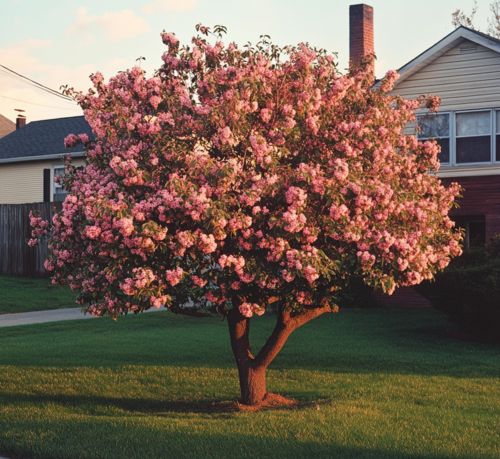
A Beautiful Flowering Crabapple Enhances a Front Yard
Crabapple (Malus spp.)
Crabapple trees are versatile ornamentals that come in a variety of shapes and sizes. These trees offer year-round interest, starting with white, pink, or red blooms in spring, transitioning to green or purple leaves in summer, and producing colorful fruits that persist into winter, attracting birds.
- Height & Spread: 6 to 20 feet tall and 6 to 8 feet wide.
- Planting Requirements: Full sun; USDA Zones 4-8.
- Special Note: Newer disease-resistant varieties like ‘Adirondack’ are excellent choices for low-maintenance gardens.
Serviceberry (Amelanchier spp.)
Serviceberry trees are prized for their year-round appeal, offering fragrant white flowers in spring, edible berries in summer, and vibrant fall foliage. These native trees can be grown as multi-stem or single-stem specimens.
- Height & Spread: 12 to 15 feet tall and 6 feet wide.
- Planting Requirements: Full sun to part shade; USDA Zones 4-9.
- Special Note: Birds love the berries, making this tree ideal for wildlife-friendly gardens.
Redbud (Cercis spp.)
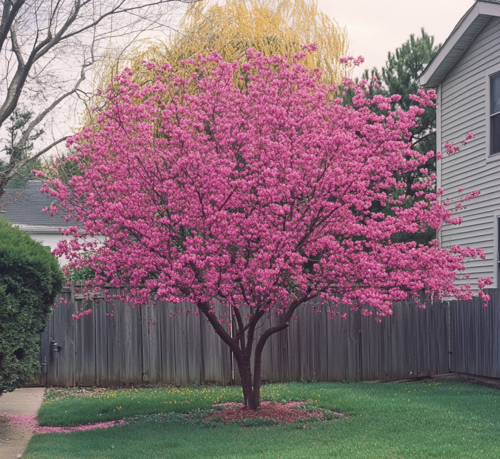
A Redbud Tree Adds a Splash of Color to the Backyard
Redbuds are native trees that thrive in various climates, offering striking purple-pink blooms in spring, heart-shaped green leaves in summer, and pale yellow foliage in fall. There are varieties for all parts of the country: eastern redbud (C. Canadensis) and western redbud (Cercis occidentalis).
- Height & Spread: 15 feet tall and 10 feet wide.
- Planting Requirements: Full sun to part shade; USDA Zones 4-9 (varies by species).
- Special Note: Popular varieties include ‘Cherokee’ and the weeping ‘Lavender Twist’.
Black Tupelo (Nyssa sylvatica)
Black tupelo, also known as black gum, is renowned for its glossy green leaves and vibrant fall colors. It is a slow-growing shade tree that attracts wildlife with its small purple fruits. The tree will have primarily male or female flowers. “Miss Scarlet” is a variety with all-female flowers. If you want to provide fruit for wildlife, planting more than one will do the trick.
- Height & Spread: Up to 50 feet tall and 30 feet wide.
- Planting Requirements: Full sun; USDA Zones 4-9.
- Special Note: This tree thrives in wet soils, making it suitable for properties near streams or wetlands.
Arborvitae (Thuja spp.)
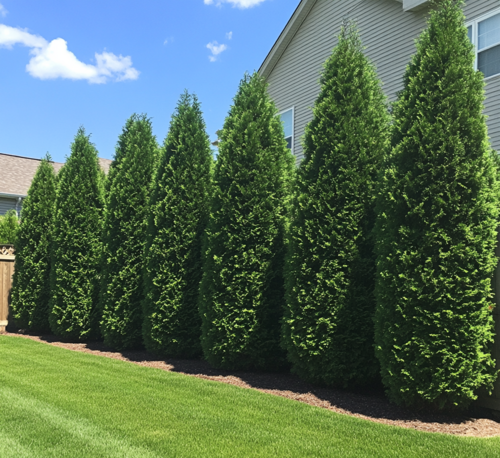
Arborvitae Trees Create a Natural Privacy Barrier
Arborvitae is a popular evergreen used for privacy screens and hedges. It comes in various forms, including pyramidal, rounded, weeping, and pendulous types. Many arborvitae varieties are fast-growing, while others, especially dwarf types, are slower. American arborvitae ( T. occidentalis ) is an eastern native species, and giant arborvitae ( T. plicata ) is also called western red cedar.
- Height & Spread: Varies by variety; some grow up to 60 feet tall.
- Planting Requirements: Moist, well-drained soil in full sun; USDA Zones 2-7.
- Special Tip: Plant at least 15 feet from structures to accommodate mature size and ensure proper airflow.
The Worst Trees to Plant Near Your House
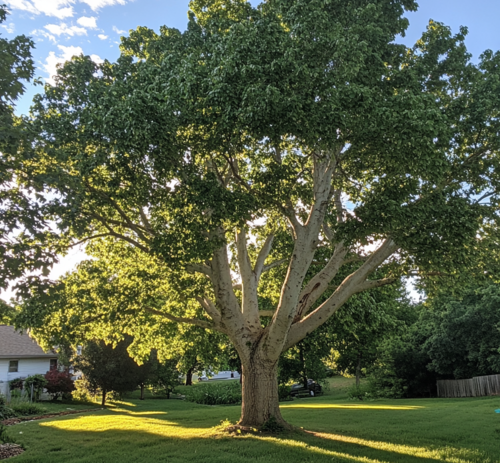
A Large Sycamore Tree in a Suburban Backyard
Sycamore (Platanus occidentalis)
Sycamores are massive trees with flaky bark and sprawling canopies. While their shade is appealing, they shed large leaves, twigs, and bark year-round, creating significant maintenance demands. Sycamores are prone to diseases like anthracnose, which causes premature leaf drop. The roots are aggressive, often damaging foundations, driveways, and sewer lines.
- Height & Spread: Up to 100 feet tall and wide.
- Drawback: Messy and prone to structural damage.
- Recommendation: Plant sycamores only in large open areas, far from buildings and infrastructure.
Ornamental Pear (Pyrus calleryana)
Ornamental pears, like the Bradford pear, are fast-growing but invasive. Their weak branch structure often leads to breakage during storms, and their unpleasant-smelling flowers detract from their spring appeal. Despite being initially thought to be sterile, they also spread aggressively, outcompeting native plants and causing them to be banned in some areas.
- Height & Spread: Up to 40 feet tall and 30 feet wide.
- Drawback: Weak branches and invasive spread.
- Recommendation: Replace with native flowering trees like serviceberry or dogwood.
Norway Maple (Acer platanoides)
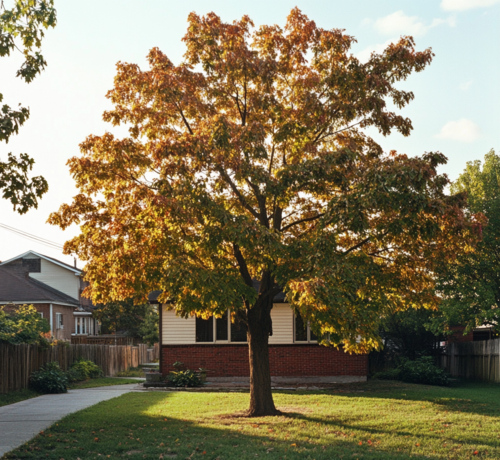
A Norway Maple Tree Highlights a Small Backyard
Norway maples are notorious for their invasive tendencies, shading out native plants and stunting growth in surrounding vegetation. They form dense canopies that block sunlight, making it difficult for grass and other plants to grow underneath. Their shallow root systems compete aggressively for nutrients. This tree’s ability to thrive in poor conditions has led to its classification as invasive in many areas.
- Height & Spread: 40 to 50 feet tall and wide.
- Drawback: Invasive roots and seedlings.
- Recommendation: Opt for less aggressive maples, like the sugar maple, for similar aesthetics without the drawbacks.
Silver Maple (Acer saccharinum)
Silver maples are fast-growing but have brittle wood, leading to frequent branch breakage. This tree, also know as the soft maple or river maple, has invasive roots that often damage nearby structures and utilities. Additionally, their prolific seed production can lead to unwanted seedlings sprouting throughout your yard. Although once popular in the housing boom of the 1950's, their high maintenance needs make them a poor choice for residential areas.
- Height & Spread: Up to 80 feet tall and 60 feet wide.
- Drawback: Weak limbs and invasive roots.
- Recommendation: Choose sturdier alternatives like red maples, tulip poplars, or oaks.
- Side Note: They are excellent for rain gardens farther from the house.
Sweet Gum (Liquidambar styraciflua)
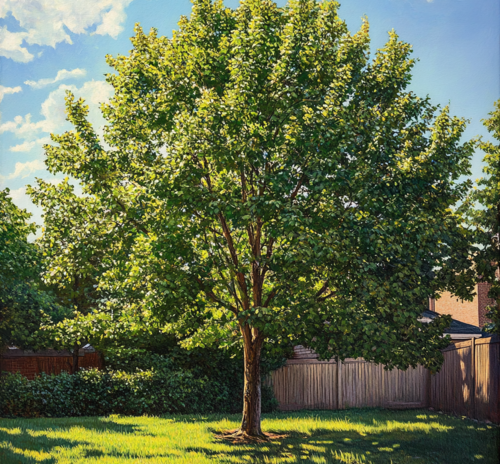
A Sweet Gum Tree in a Residential Yard
Sweet gum trees are valued for their striking fall foliage, which ranges from yellow to deep red. However, their spiky seed balls are a major nuisance, littering lawns and creating trip hazards. These trees also have aggressive root systems that can damage nearby sidewalks and driveways. While they are native and support wildlife, their maintenance challenges often outweigh their benefits.
- Height & Spread: Up to 75 feet tall and 50 feet wide.
- Drawback: Messy and potentially dangerous seed balls and invasive roots.
- Recommendation: Plant sweet gum trees in large, open areas where their seed balls won’t pose hazards. Alternatively, consider seedless sweet gum cultivars or other colorful native trees like black tupelo.
What Makes a Tree the Best?
The best trees for planting near your home are those that offer a combination of beauty, functionality, and practicality. These trees should:
- Provide Multi-Seasonal Interest: Look for trees that offer blooms in spring, attractive foliage in summer, vibrant colors in fall, or ornamental bark in winter. This ensures your landscape remains appealing year-round.
- Be Low-Maintenance: Disease resistance and minimal pruning requirements are key traits of a good tree. A healthy, self-sustaining tree reduces long-term care costs and effort.
- Have Non-Invasive Roots: Trees with non-invasive root systems are safer for foundations, driveways, and underground utilities.
- Enhance Property Value: Trees that improve curb appeal and provide practical benefits like shade or windbreaks add tangible value to your home.
- Support Local Wildlife: Native species that attract pollinators, birds, and beneficial insects contribute to a thriving ecosystem in your yard.
- Adapt to the Environment: The best trees thrive in your local climate and soil conditions, reducing the need for intensive care or water usage. Native or well-adapted species are particularly advantageous.
What Makes a Tree the Worst?
The worst trees are those that:
- Create Excessive Mess: Trees that frequently drop leaves, branches, or seed pods can require constant cleanup, adding to maintenance costs and labor.
- Have Weak or Brittle Wood: Trees with fragile limbs are prone to storm damage, posing risks to property and safety.
- Exhibit Invasive Behavior: Trees with aggressive root systems or prolific seedlings can harm local ecosystems and cause structural damage to buildings, driveways, and underground utilities.
- Produce Hazardous Debris: Trees that drop large fruits, spiky seed balls, or other dangerous debris can create tripping hazards and detract from yard usability.
- Attract Pests or Diseases: Certain species are highly susceptible to pests or diseases, which can quickly spread and jeopardize nearby vegetation.
- Grow Too Large for Their Space: Oversized trees can overshadow homes, block sunlight, and lead to costly pruning or removal down the line.
The Basics of Planting Trees Around Your Home
- Plan for Growth: Research the tree’s mature size to ensure it fits the available space without overcrowding or interfering with structures.
- Choose the Right Spot: Match the tree’s sun, shade, and soil requirements to its planting location. Proper placement ensures healthy growth and reduces maintenance.
- Prepare the Soil: Loosen the soil and enrich it with organic matter to promote strong root development. Ensure proper drainage to prevent waterlogging.
- Water Regularly: Water newly planted trees weekly during the growing season for the first three years to establish a robust root system.
- Fertilize Appropriately: Use a balanced fertilizer according to label directions to support healthy growth without overfeeding.
- Mulch Wisely: Apply a 2-3 inch layer of mulch around the tree’s base to retain moisture, regulate soil temperature, and reduce weed competition. Avoid piling mulch against the trunk.
- Prune as Needed: Remove dead or damaged branches to encourage healthy growth and shape the tree as it matures.
- Think Long-Term: Select trees that will thrive in your landscape for decades, considering their aesthetic, functional, and ecological contributions.
Conclusion
Selecting the right trees for your property is a long-term investment that enhances your home’s beauty and value. Avoid common mistakes by choosing low-maintenance, non-invasive species and planting them in the right location. If you need expert advice, contact Arborist Now for a professional consultation to ensure your landscape thrives for years to come!
AUTHOR: Jo Ellen Meyers Sharp is an award-winning garden writer, editor, and speaker. Known as a "hortiholic," she frequently says her eyes are too big for her yard. She blogs at hoosiergardener.com.
Originally posted on October 17, 2022.





